
October 13, 2011 Ryukyu Shimpo
Kicking off a four-day schedule of events, the opening ceremony of the 5th Worldwide Uchinanchu Festival was held in the evening of October 13 at Okinawa Cellular Stadium in Naha City. In his greeting speech on behalf of the organizers, Governor of Okinawa Hirokazu Nakaima addressed the participants saying, “You are a treasure of Okinawa – we are proud of you! We sincerely hope that together with local residents, the participants from abroad will enjoy the full range of events over the next four days.”
The opening ceremony was attended by many distinguished guests, including Mr. Neil Abercrombie, the current governor of Hawaii. The “Worldwide Simultaneous Eisa Pageant,” which was also held as part of the evening’s entertainment, was an exciting event in which about 300 people, including members of overseas Kenjinkai there in person at the Okinawa Cellular Stadium joined Kenjinkai members back in their own countries in enjoying eisa at exactly the same time. This immediately lifted the atmosphere inside the venue to a fever pitch.
For the 5th Worldwide Uchinanchu Festival, the number of participants from 23 overseas and two regions reached a record-high of about 5200, and if we count those from other prefectures, there were over 6000 participants. Many exchange events, including the Champloo Festa, will be held during the period until October 16.
(English Translation by T&CT, Mark Ealey)
Go To Japanese
Slideshow of One heart Uchinanchu at the opening ceremony of 5th Worldwide Festival
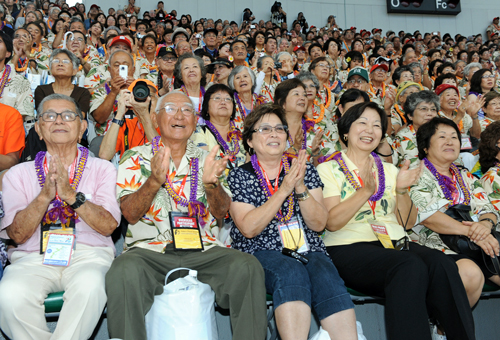

Go To Video
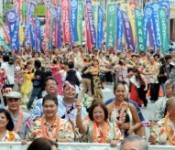
October 12, 2011 Ryukyu Shimpo
Several thousand people from 23 countries and two regions who came to participate in the 5th Worldwide Uchinanchu Festival marched in matching regional and national costumes in a parade in Kokusai Street in Naha City, at 4:00pm on October 12. Brazilian participants led by 1000 members of the samba corps moved lightly on their feet dancing to the rhythm of the drums during the parade.
The Hawaii Uchinachu troupe performed the hula dance in brightly colored costumes. Crowds of local residents who packed the sides of the road responded with hearty applause and high-fives, bringing a tangible air of excitement to Kokusai Street.
The opening ceremony of the festival will be held at the Okinawa Cellular Stadium in Naha City at 5:00pm on October 13. Many interactive events have been arranged for during the festival that lasts four days until October 16. According to the executive committee of the 5th Worldwide Uchinanchu Festival, approximately 6000 people from overseas or outside the prefecture will come to Okinawa.
(English Translation by T&CT, Mark Ealey)
Go To Japanese
Slideshow of 5th Worldwide Uchinanchu Festival parade
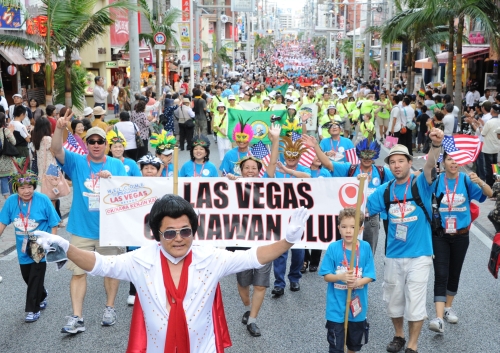

Go To Video
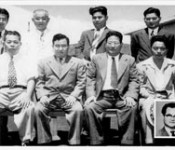
October 8, 2011 Tsuyoshi Arakaki of Ryukyu Shimpo
The Executive Committee of the 5th Worldwide Uchinanchu Festival will formally recognize the efforts of seven brave people of Okinawan origin who brought 550 pigs for Okinawan people suffering from severe food shortages in 1948. On October 13, at the opening ceremony of the festival, the committee invited their families to come, and will present them with certificates of appreciation and commemorative gifts or items of Ryukyuan craft. Two family members are confirmed to be participating in the ceremony and five others are yet to be confirmed. The committee will send the commemorative items by mail to those who not able to visit here. A representative of the committee said, “We consider their achievements to be an essential piece of the history of the Worldwide Uchinanchu network. We must not let this be watered down by the passage of time.”
The presentation will be held at the beginning of the photo exhibition, “Pigs came from the Sea” (Umi Kara Buta ga Yatte Kita), a festival-related event to be held in a special hall for the “Migration Documents and Materials Exhibition for the Worldwide Uchinanchu Festival” at the Okinawa Prefectural Museum & Art Museum in Naha City, at 10:00am on October13.
The last survivor of the seven brave Okinawans was Yasuo Uezu, who passed away on July 20 at the age of 91. In August, at the general meeting of planning committee for the festival, the Okinawa-Hawaii Association proposed that we demonstrate our appreciation of their achievements. Then, the members of the committee made every effort to collect contributions to cover the cost of travel for the relatives.
Pork-industry related companies and organizations such as Okinawa Ham, the Association for Hog Raising, Okinawa Prefectural Livestock Industry Promotion Foundation, Ganaha Husbandry, Ryukyu Kyodo Feed Mfg., Naha Meat, Okinawa Hormel and Okinawa Prefectural Feed Manufacturers Cooperative Union provided a total of two million yen in response to the request from the committee.
The seven people who brought the pigs to Okinawa were Uezu, Yoshio Yamashiro, Genbi Tonaki, Ushikichi Nakama, Shinei Shimabukuro, Shohei Miyasato and Ryoshin Agena. They purchased pigs on mainland United States and chartered a U.S. military transport ship to get the pigs to Okinawa. They then risked their own lives to deliver them to the people of Okinawa, sailing through stormy weather and through floating mines placed by Japanese military during the war. In addition to this brave act of kindness, many people of Okinawan origin living in North and South America, and other countries, shipped large amounts of various supplies to the people of Okinawa.
Hidenobu Chinen, secretary-general of the executive committee of the 5th Worldwide Uchinanchu Festival said, “We would like to thank the many companies that contributed to raising funds for this initiative.”
(English Translation by T&CT, Mark Ealey)
Go To Japanese
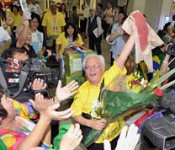
October 7, 2011 Ryukyu Shimpo
On October 6, it was reported that the number of people planning to come to Okinawa from other prefectures and countries to take part in the 5th Worldwide Uchinanchu Festival has reached a record-high of almost 6000. The festival will be held over a four-day period from October 13 mainly at the Okinawa Cellular Stadium in Naha, with a preliminary event on October 12, the night before of its opening.
The figures are calculated from the number of people who have officially registered to participate in the festival. As of October 6, the total number of people who will participate in the festival from outside the prefecture amounted to 5899. Among them, participants from overseas countries amounted to 5191, the first time that this figure has exceeded 5000 people so the prefecture is readying itself for the largest worldwide Uchinanchu Festival ever.
The first group of 53 group participants from Brazil arrived at Naha Airport in the evening of October 6. According to a spokesperson of the 5th Worldwide Uchinanchu Festival Executive Committee, dozens of participants from outside the prefecture are coming into Okinawa every day. The spokesperson said, “Another 100 people are estimated to participate from the opening day of the festival.”
The number of participants is estimated to end up at around 6000. The number from outside the prefecture for the 4th Worldwide Uchinanchu Festival was 4937, which was the largest number to date.
As of October 6, the participants from other prefectures amounted to 708, up by 164 compared with the previous festival. People from 23 countries and two regions (Hong Kong and New Caledonia) will participate.
In the breakdown of numbers of participants by countries, the United States claimed the top spot with 2898 (1060 from Hawaii), followed by Brazil with 1177, up 2.7 times from the previous festival, Peru with 325, up 30, and Argentina with 275, up 115, and Canada with 164, up 32.
The prefecture also welcomes participants from Guatemala (two) and Cambodia (four) for the first time.
The first group of 53 participants from Brazil were enthusiastically welcomed by around 100 people, including relatives, who looked forward to getting reacquainted with them or meeting them for the first time, the prefecture’s Deputy Governor Yoshiyuki Uehara and Miss Okinawa in the arrivals area of Naha Airport.
The participants from Brazil and their relatives hugged each other emotionally, filling the area with happy cries and an air of excitement.
(English Translation by T&CT, Mark Ealey)
Go To Japanese

Go To Video
October 4, 2011 Ryukyu Shimpo
Despite the Japanese government having paid about 122 billion yen since 2009 as their share of the burden of the cost of relocating the United States Marines Corps in Okinawa to Guam, the use of this money is still up in the air. This was revealed by a reporter of the Ryukyu Shimpo in an interview at the Ministry of Defense on October 3. Fiscal 2011’s allocation of 51.9 billion yen has not yet been transferred to the United States, but from the previous two fiscal years of 2009 and 2010, about 75 billion yen, over 90% of the 81.4 billion yen already paid by Japan to the United States, still sits unused.
Backlogged budgets are thought to be the cause of delays on the environmental impact assessment in Guam and the fact that the relocation burden on the U.S. side has been cut by U.S. Senate leaving actual relocation nowhere in sight.
The Ministry of Defense has requested that 51.9 billion yen by allocated from the fiscal 2012 budget for relocation of the Marines to Guam, the same amount as the 2011 year, but it is possible that this may not be permitted because the circumstances surrounding the relocation to Guam do not look as though they will change in future.
The retention of such a large amount of public funds clearly indicates that the U.S. military realignment agreed upon in 2006 by the United States and Japan to enhance the efficiency of U.S. military operations and to reduce the burden on Okinawa has again returned to a stalemate.
In 2006, the governments of the two countries agreed on the respective apportionment of expenses for the relocation of the Okinawa Marine Corps to Guam. The Japanese government is spending $2.8 billion in the form of direct expenses or government pump priming for facility maintenance such as headquarters buildings and in addition to this, it is providing financing to the United States to the tune of 32.9 billion dollars for the likes of water and sewage infrastructure, electric power and family housing.
The Japanese government paid 34.6 billion yen to the United States in fiscal 2009 and 46.8 billion yen in fiscal 2010, and except for some expenditure on the likes of tendering for facilities design, most of the budget remains untouched. This July, the U.S. Senate removed from the fiscal 2012 U.S. government budget the full amount of $150 million (about 12 billion yen) for the Guam relocation, which is linked with the Futenma relocation, because the realization of the plan is surrounded in uncertainty.
(English Translation by T&CT, Mark Ealey)
Go To Japanese
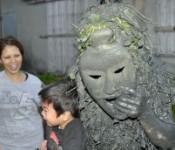
October 4, 2011 Ryukyu Shimpo
A traditional pantou event, in which “gods” covered with mud and grass smear mud on people or things in order to drive away bad luck, was held on October 2 and 3 in the Hirara Shimajiri district of Miyakojima City. In Japan, this traditional event is designated as an important intangible cultural asset.
Every year, Shimajiri pantou “gods” visit the village on a lucky day of the lunar calendar in September. On that day, three pantous cover themselves with grass and mud from the well used for a baby’s first bath (nmariga), before going out into in the village where they first put mud on the patriarch of the village elder’s family called muto.
The three pantou then split up and go their separate ways through the village, daubing mud on residents and visitors alike, as well as objects such as new houses, cars, people young and old without asking people whether or not they want this to happen.
However because it is done to drive away bad luck, most people happily accept having mud smeared on them, but not surprisingly many children simply run away screaming. Some parents even hold out their children to the pantou to have them daubed with mud, but the pantou ignores requests from children and tourists who come up saying, “Please smear mud on me.” The unpredictable movements of the pantou “gods” certainly helped to lift the mood among people that particular night. Shizu Shimajiri, a 79 year-old resident whose new house was visited by the pantou happily said, “Welcome pantou! Come right in and drive away bad luck! I want to stay healthy!”
(English Translation by T&CT, Mark Ealey)
Go To Japanese

Go To Video
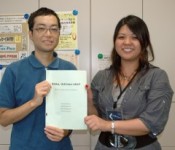
October 2, 2011 Ryukyu Shimpo
Part-time teacher at Seisa Kokusai High School Masashi Sakihara and three academics studying the Okinawan dialect are creating a textbook called Rikka, Uchinaa-nakai! that is designed to help people learn the Okinawan dialect through the medium of English.
They intend to print an initial run of 400 copies, timing this to coincide with the upcoming 5th Worldwide Uchinanchu Festival, and to present them to the people involved with Okinawa Kenjinkai (associations of people from Okinawa) and researchers who teach the Okinawan dialect in the United States.
The three other people working with Sakihara on the project are Professor Shigehisa Karimata and Associate Professor Seisei Shimabukuro of the University of the Ryukyus and research associate Lucila Etsuko Gibo. The four of them have been working since 2009 on this project initiated by the University of the Ryukyus.
The textbook has a total of 15 lessons and adopts a narrative form in which third-generation Okinawan-Americans Amy and David travel around Okinawa, learning about its geography and history. Taking into account feedback from people who review the book, the creators intend to publish four textbooks in which there will be a total of 50 lessons.
They plan to publish the textbooks and within two years to establish a teaching program using the books.
The creators are also in the process of translating the text into Portuguese for Okinawan Brazilians currently residing in the prefecture and hope to complete the translation of the 15 lessons before the end of the year.
Sakihara said, “We would like Okinawans, or people of Okinawan descent who now live overseas, to make use of this textbook.”
For further details, call the International Institute for Okinawa Studies at the University of the Ryukyus at 098 (895) 8475.
(English Translation by T&CT, Mark Ealey)
Go To Japanese
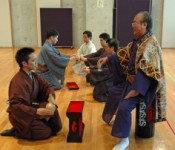
October 2, 2011 Ryukyu Shimpo
The Okinawa Prefectural Performing Arts Association or Okigeiren (Chaired by Choichi Terukina), is planning to go on a tour from late October to early November that includes Paris in France, Cologne in Germany, and Rome in Italy. Termed the “Ryukyu Traditional Arts Performances Three European Countries Tour,” it will feature performances of kumiodori or traditional Okinawan musical and classical music. With kumiodori being designated as an Intangible Cultural Heritage of the United Nations Educational, Scientific and Cultural Organization (UNESCO), the association is now hoping to introduce the outside world to the fabulous appeal of kumiodori during the European tour.
Five performances are scheduled on tour, including October 28 and 29 in Paris, October 31 in Cologne, and November 2 in Rome. In 2009 Shinjin Kise, a Japanese Cultural Ambassador appointed by the Agency for Cultural Affairs, demonstrated the splendor of Okinawan classical music overseas. His activities served to open the door for Okigeiren to plan the European tour with funding by Agency for Cultural Affairs.
During the tour, experienced dancers designated as important intangible cultural assets will be assisted by younger performers to present the kumiodori play Nidou tekiuchi (trans: Revenge for two children). It includes the grief-stricken separation of the mother and her children, followed by a tense scene of revenge. Choichi Terukina, a national human treasure of classical music, will sing the accompaniment as he plays his sanshin.
The ryubu or Okinawan dance performance program includes the likes of Kagiyadefu bushi, Inimazun, Wakashu kuteibushi and Hatumabushi. Setsuko Tamagusuku, the chairwoman of the Ryubu Hozonkai (Association for the Preservation of Okinawa Classical Dance) is down to perform the Kasekake. Terukina and Kise will also give solo performances.
Terukina, who is the principal of the troupe said, “The kumiodori overseas performance represents a unique opportunity for us. The audience doesn’t understand the language used so we will be happy if they just feel something good through our performance.”
(English Translation by T&CT, Mark Ealey)
Go To Japanese
October 5, 2011 Ryukyu Shimpo
On October 4, Defense Minister Yasuo Ichikawa announced that in keeping with the agreement reached to help ease the base-hosting burden of Okinawa, from October 10 the Japanese and U.S. governments will relocate some of the U.S. Marine Corps fighter jet drills currently held at the U.S. Kadena Air Base to Guam.
This is the first time since the agreement was entered into that Japan and the United States will implement the relocation of such drills to Guam, and on this occasion, drills involving about 20 F/A-18 Hornet fighters based at the U.S. Marine Corps Air Station Iwakuni in Yamaguchi Prefecture will be transferred to Guam.
The shift of venue is scheduled to continue until October 31 and this particular relocation is reported to be the largest carried out to date.
The Japanese government will cover three quarters of the cost of the relocation, with the U.S. government bearing the remaining one quarter.
The transfer of the drills, including the one scheduled to be held from 10 October, is due to be carried out in two or three phases until next March and then to be continued beyond fiscal 2012.
Ichikawa said, “Noise in the areas around Kadena Air Base is a serious problem. We would like to continue deliberations on this issue with U.S. military and do our best to reduce noise to the greatest extent possible.”
The ministry also intends to transfer drills for pilots of U.S. Air Force F-15s from the Kadena base to Guam.
But at the same time, local residents in Okinawa are not all confident that the drill relocation will actually reduce the noise level, because in the past during such relocation of drills other U.S. military aircraft based in South Korea have come to conduct exercises at Kadena. However, a ministry official expressed the view that on the this occasion the U.S. military will refrain from holding other exercises there while the relocation is carried out, saying, “The Japanese government has reached an agreement with the U.S. government on that matter.”
With regard to the relocation of the drills, Japanese Foreign Minister Koichiro Gemba talked to the press on October 4, saying, “This is a concrete measure designed to resolve the noise issue, and it contributes to the reduction of Okinawa’s base-hosting burden. While engaging in ongoing discussions with the U.S. government, we need to do even more to resolve issues such as incidents [of crime], accidents and the problems of noise.”
Both the Japanese and the U.S. governments have been expanding efforts to relocate some of the U.S. Marine Corps fighter jet drills held at the U.S. Kadena Air Base to Japan Air Self-Defense Force bases outside Okinawa Prefecture. Both governments reached agreement on the relocation of the drills to Guam and are in the process of arranging the specific timing of its implementation.
(English Translation by T&CT, Mark Ealey)
Go To Japanese
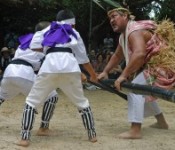
October 1, 2011 Ryukyu Shimpo
The Kitsugan Festival organized to pray for a good harvest and perfect health for all in their region was held on September 24 at Nnibushi Utaki (a sacred place) in Kabira, Ishigaki City on Ishigaki Island.
These last three years, inclement weather at the time of the festival has seen it held at the Kabira Farming Village Settlement Center, but favorable weather this year meant that it could be held at its rightful venue of Nnibushi Utaki.
After kamitsukasa, or a type of flamen, worshiped in front of the altar, a person dressed as a maitreya danced together with the rest of the participants. One after another, young participants dedicated their performances to the gods. There were lively displays of bojutsu (staff-wielding) and lion dances accompanied by drums.
Two elementary-school pupils pitted themselves against a very large opponent in the three-man bojutsu kumite performance, which is unique to Kabira. The spectators were clearly impressed by the vigorous performance involving a giant man on one side and agile young pupils on the other. Local residents of Kabira Village and tourists alike enjoyed this year’s festival.
(English Translation by T&CT, Mark Ealey)
Go To Japanese



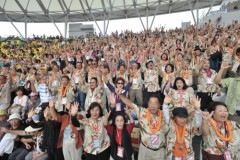
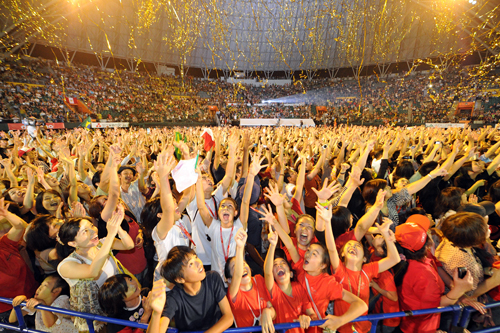












 Webcam(Kokusai Street)
Webcam(Kokusai Street)


